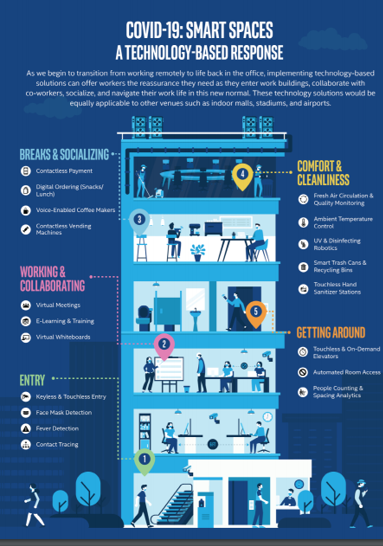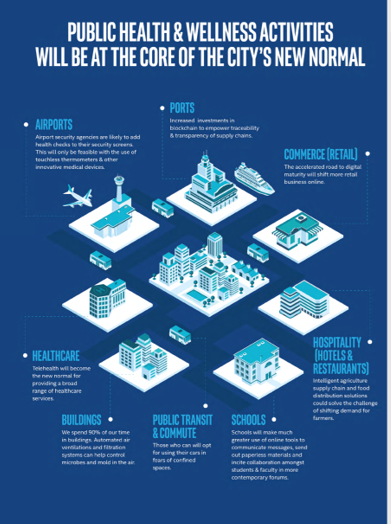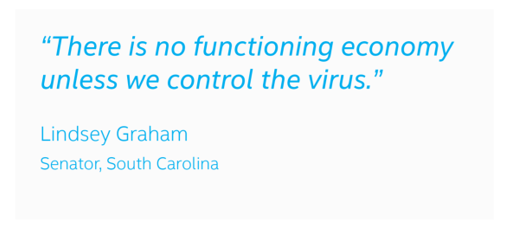The coronavirus pandemic added a new concept to our collective, popular lexicon: “social distancing” and “physical distancing.” This was one pillar for the public health prescription we were given to help mitigate the spread of a very tricky, contagious virus.
 A major negative impact of our sheltering in place, working from home, and staying indoors has been a sort of clearing out of cities where people congregate for work, for culture, for entertainment, for education, for travel and tourism…for living out our full and interesting lives and livelihoods.
A major negative impact of our sheltering in place, working from home, and staying indoors has been a sort of clearing out of cities where people congregate for work, for culture, for entertainment, for education, for travel and tourism…for living out our full and interesting lives and livelihoods.
Intel gave Harbor Research a mandate to “re-imagine life in a post-pandemic world,” with a keen lens on smart cities and transportation. Their report envisions a new normal for physical spaces, public transit and commuting, airports, urban infrastructure redevelopment, remote work, and public health.
This is a rich report covering key vertical markets: public safety, transportation, education, transformative tech, smart cities, and health care. In this post, I’ll focus on health care, but the other verticals are all adjacent to health, so I recommend you visit the entire document and learn from the wisdom therein.
I’ve pulled two illustrations out of the report that speak to the way I’ve been re-considering health and especially our homes as health hubs. The first graphic here imagines our work-life balance as we transition from working remotely to life back int he office, leveraging technologies for the various risk-events we would encounter in the experience. These include:
- Entry
- Getting around inside the building
- Working and collaborating
- Breaks and socializing, and
- Comfort and cleanliness.
This last of the five life-flows is perhaps the most impactful one on our Maslow Hierarchy of Needs pyramids: the need to be physiologically safe from harm — in this case, exposure to the coronavirus in the workplace.
This workplace envisions a contactless/touchless, ever-disinfecting and hygienic environment. Sensors detect fever, face mask wearing, people counting, and fresh air monitoring and circulation.
 The report envisions that public health and wellness activities will be at the core of the city’s new normal. Even after a vaccine would be developed, a full return to “everyday life as we knew it before” would be a “strange non sequitur,” Harbor Research writes.
The report envisions that public health and wellness activities will be at the core of the city’s new normal. Even after a vaccine would be developed, a full return to “everyday life as we knew it before” would be a “strange non sequitur,” Harbor Research writes.
Smart technologies will be more relevant to us humans than ever before in history, the team asserts. Without attending to health, the economic viability of cities will be threatened.
“Data is suddenly on Maslow’s hierarchy of needs,” Adam Beck stated as leader of the Smart Cities Council for Australia and New Zealand.
Some cities in the geographies of Beck’s constituencies, in Australia and New Zealand, are cities with leadership in data culture, as Beck puts it, pointing to Wellington as an example.
Communities that leverage data across a city’s infrastructure and economic sectors have been able better manage the coronavirus pandemic spread, to “crush and contain” COVID-19 as a BCG analysis recently described those nations and regions in the world that have successfully dealt with the pandemic and resulting economic impacts.
The second graphic illustrates economic places where data can/should be collected and aggregated to enable a city to be smarter in dealing with a public health emergency. These are airports, ports, retail, hospitality (hotels, restaurants), schools, public transit, big buildings, and…healthcare.
Underpinning information sharing is the growing Internet of Things embedded in places and spaces, and open standards protocols that enable data to be liquid and mobile.
The report describes applications that take these data in complex applications fusing data from devices, people, and systems — from automated emergency response and dispatching systems, digitized health records, weather monitoring, home voice assistants, and surveillance cameras.
The report includes eight examples of healthcare innovations that fit into this vision including Medical Informatics Corp. Sickbay, Capsule Technologies, Revlis Tele-Healthcare, Medpod Health, Intouch Health, MSI AI-UVC Disinfection Robot, Pudu Delivery Robots, and Savioke Relay.
 Health Populi’s Hot Points: The report quotes both Governor Andrew Cuomo of the State of New York, saying,
Health Populi’s Hot Points: The report quotes both Governor Andrew Cuomo of the State of New York, saying,
“When we reopen after COVID-19, we’re determined to be better for it. That means reimagining our lives. There is never a return to yesterday. Life is about moving forward, taking what you’ve learned and bringing it to a positive effect.”
Governor Cuomo is a member of the Democratic Party.
The report also quotes Senator Lindsey Graham, Republican representing South Carolina. He is quoted asserting that,
“There is no functioning economy unless we control the virus.”
The unifying field theory here is that, cross party-ID, these two political leaders get the fact that public health and healthcare are integral to a healthy economy and growth. Senator Graham is absolutely right in his conviction that the economy won’t function well unless we control the virus.
We are far from there this new month of September 2020, six months into the pandemic. Getting the data and technology aspects right will be one key to nailing the pandemic — but that will also require trust and cooperation. Can stakeholders in U.S. health care, technology, education, politics, civil life, and communities come together as if we behaved like people in, say, Wellington, New Zealand?
If we want our economy and society to function well, we must.




 I'm in amazing company here with other #digitalhealth innovators, thinkers and doers. Thank you to Cristian Cortez Fernandez and Zallud for this recognition; I'm grateful.
I'm in amazing company here with other #digitalhealth innovators, thinkers and doers. Thank you to Cristian Cortez Fernandez and Zallud for this recognition; I'm grateful. Jane was named as a member of the AHIP 2024 Advisory Board, joining some valued colleagues to prepare for the challenges and opportunities facing health plans, systems, and other industry stakeholders.
Jane was named as a member of the AHIP 2024 Advisory Board, joining some valued colleagues to prepare for the challenges and opportunities facing health plans, systems, and other industry stakeholders.  Join Jane at AHIP's annual meeting in Las Vegas: I'll be speaking, moderating a panel, and providing thought leadership on health consumers and bolstering equity, empowerment, and self-care.
Join Jane at AHIP's annual meeting in Las Vegas: I'll be speaking, moderating a panel, and providing thought leadership on health consumers and bolstering equity, empowerment, and self-care.